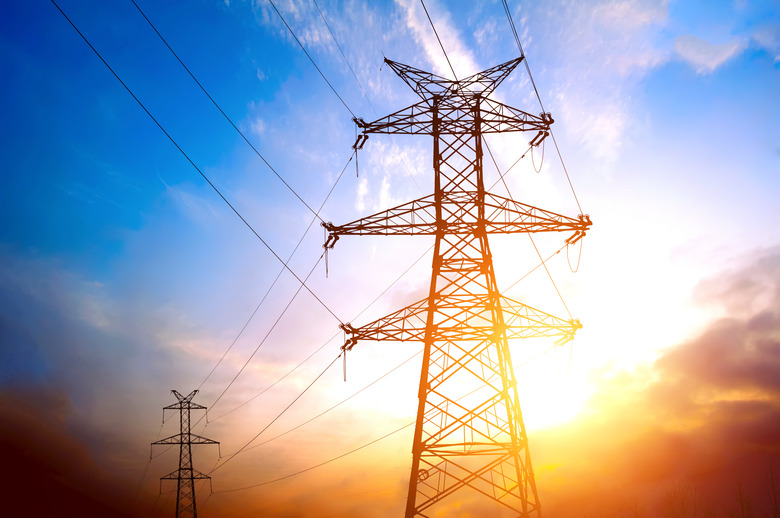What Is A Safe Distance From High Tension Electrical Wires?
Electromagnetic radiation in large amounts can be dangerous to biological systems, including human bodies. This is a source of concern given the considerable fraction of the population that lives in close proximity to high-voltage, above-ground power lines, also known as high-tension wires. A number of people use Internet "evidence" to claim that living near high-tension wires can cause serious ailments, but the actual story is not yet known. Despite that controversy, the effects of electromagnetic radiation emanating from power lines are of particular interest to neuroscientists, because the brain itself operates by sending a form of electrical signal between neurons and target tissues outside the central nervous system. Deciding how far from these wires is "safe" requires sorting through the available evidence.
TL;DR (Too Long; Didn't Read)
The minimum safe distance from high-tension electrical wires varies if your concern is for your general health. For people working near electrical wires, at least one utility company advises keeping all equipment under 14 feet tall when near power lines.
What Is Electromagnetic Radiation?
What Is Electromagnetic Radiation?
Electric fields and magnetic fields, which are related but physically distinct, are created by anything that carries electrical current, from high-tension lines to the wiring in homes to household appliances. The magnitude, or strength, of these fields diminishes quickly with increasing distance from the source that creates them.
Electromagnetic radiation also emanates from sources in outer space, including the sun and other stars and the microwaves traveling freely throughout the cosmos. Both visible light and invisible "light" (e.g., infrared and ultraviolet) constitute other examples. Electric fields interact with biological systems, including human bodies, in a different way from magnetic fields.
Health Risks of Electrical Fields
Health Risks of Electrical Fields
Despite ample public discourse about the health risks of electrical and magnetic fields, little to no conclusive evidence exists that these are harmful in quantities resulting from exposures to everyday sources, including properly installed high-tension wires in residential and commercial environments.
In electric fields that are many powers of ten stronger than those that usually exist beneath run-of-the-mill power lines, people who touch a large metal object, such as a bus, might experience a transient shock. Otherwise, no health effects have been reported. The same is true of magnetic fields, although some studies have identified small changes in cellular calcium levels, hormone production and cell growth.
There are people who claim to be affected by a condition called electromagnetic hypersensitivity, or EHS, but concrete evidence of negative effects still hasn't been found in research. Symptoms of EHS range from nausea and rashes to muscle aches. The World Health Organization noted in 2005 that research has been unable to replicate symptoms in individuals with EHS; in multiple studies, the subjects were unable to detect electromagnetic fields with any more accuracy than subjects who did not have EHS. Yet in 2015, a literature review in "Reviews on Environmental Health" described mixed results, with some of the reviewed studies finding no link and others finding minute biological changes after exposure.
Summary of the Evidence
Summary of the Evidence
If you live near high-tension power lines, your health, according to the body of current research, is not really at risk from the fields produced.
Nevertheless, while the electric and magnetic fields emanating from high-tension wires are not considered dangerous by medical researchers, this does not make these constructs safe in the global sense, as direct contact can cause shocks. Avoid bringing yourself or anything you are holding too close to high-tension wires overhead. In addition, do not try to pass under a power line with any object, including a vehicle, that could come close to these wires. According to the Bonneville Power Administration in Oregon, as a general rule, when you are under a line, you should not place yourself or any object any higher than 14 feet above the ground when near power lines.
Cite This Article
MLA
Beck, Kevin. "What Is A Safe Distance From High Tension Electrical Wires?" sciencing.com, https://www.sciencing.com/safe-high-tension-electrical-wires-7639708/. 7 May 2018.
APA
Beck, Kevin. (2018, May 7). What Is A Safe Distance From High Tension Electrical Wires?. sciencing.com. Retrieved from https://www.sciencing.com/safe-high-tension-electrical-wires-7639708/
Chicago
Beck, Kevin. What Is A Safe Distance From High Tension Electrical Wires? last modified August 30, 2022. https://www.sciencing.com/safe-high-tension-electrical-wires-7639708/
